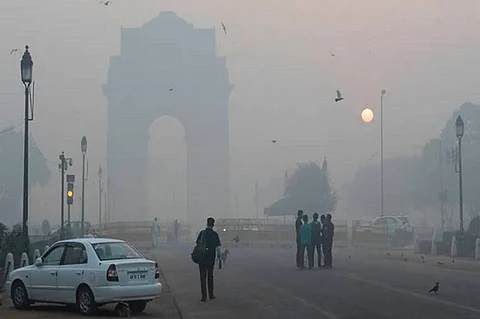
- Home
- NG Hindi
- India
- World
- Politics
- Sex & Relationships
- Entertainment
- Culture
- Lifestyle
- Economy
- Sports
- Sp. Coverage
- Misc.
- NewsGram Exclusive
- Jobs / Internships

With the constant dip in mercury and air quality aggravating from moderate to poor to the very poor category in the national capital and its surrounding areas, the hospitals in Delhi are getting flocked by patients of asthma, chronic obstructive pulmonary disease (COPD), and other acute respiratory illnesses.
While the health experts have been witnessing an almost 20 percent rise in the number of such patients for the last two weeks, the influx of patients with no prior respiratory illness is also increasing with symptoms of asthma.
Follow NewsGram on Twitter to stay updated about the World news.
Moreover, the experts have warned that long term exposure to severely polluted air could also result in the development of cancer.
Desh Deepak, a pulmonologist at the Centre-run Ram Manohar Lohia Hospital (RML), said that air pollution has been well-recognized as a cancer-causing agent.
Follow NewsGram on Instagram to keep yourself updated.
"Air pollution is a Class, 1 cancer-causing agent. It is a certified carcinogen recognized by the World Health Organization (WHO). Long-term exposure to it could turn it into cancer," he explained.
A carcinogen is any substance, radionuclide, or radiation that promotes carcinogenesis, the formation of cancer. This may be due to the ability to damage the genome or because of the disruption of cellular metabolic processes.
Patients already having respiratory illnesses are at the receiving end of this situation (air pollution). Their complications have aggravated. Flickr
Concurring with Deepak, Manish Sharma, medical oncologist at the Rajiv Gandhi Cancer Institute and Research Centre, said that air pollution is directly associated with the development of lung cancer.
"In 2013, the International Agency for Research in Cancer (IARC) had categorized air pollution as Group 1 carcinogen for lung cancer and Group 2A for several other kinds of cancers. It means that air pollution is directly responsible for lung cancer. However, an association with other kinds such as bladder cancer, breast cancer, and esophagus cancer is probable," he explained.
Follow NewsGram on Facebook to stay updated.
Sharma also stated that air pollution is exacerbating mortality among cancer patients by a whopping 22 percent. He pointed out that every 10 micrograms per cubic meter increased exposure to PM 2.5 leads to the risk of dying from cancer by 22 percent.
"A recent study done in Hong Kong on over 66,000 patients revealed that the risk of death in cancer patients getting treatment in polluted areas increases by 22 percent in comparison to patients who receive treatment in non-polluted regions," Sharma explained.
Want to read more in Hindi? Checkout: राजकुमार राव ने अपने पीटी टीचर से जुड़ा मजेदार किस्सा किया साझा
He added that the risk of cancer in new-borns also increases when their mothers get exposed to pollution while expecting.
Karan Madan, professor at the Department of Pulmonary Critical Care and Sleep Medicine, All India Institute of Medical Sciences (AIIMS), observed that a high level of pollution is triggering asthma among people having no pulmonary disorders.
The risk of cancer in new-born also increases when their mothers get exposed to pollution while expecting. Flickr
"The rise of PM 2.5 level is clearly linked to increased problems with lung health. We have been diagnosing patients with no pre-existing respiratory problems exhibiting symptoms of asthma and other pollution-related lung diseases. Besides, the pollution is also aggravating the severity of respiratory diseases in patients with pre-existing pulmonary illnesses," he added.
Anil Chaudhry, a senior consultant at Rajan Babu Institute of Pulmonary Medicine and Tuberculosis (RBIPMT), said that an extreme rise in pollution coinciding with winters observed these days have worsened 90 percent of the cases with pre-existing respiratory illnesses.
Follow NewsGram on LinkedIn to know what's happening around the world.
"Patients with asthma and COPD do experience exacerbations in the winter. Changes in temperature and humidity contribute to seasonal infections. Further, air pollution is also a major threat. Patients already having respiratory illnesses are at the receiving end of this situation (air pollution). Their complications have aggravated," he added.
Meanwhile, Deepak informed that the hospitals are receiving up to a 20 percent rise in patients suffering from chronic respiratory illnesses.
"It is an annual feature where the footfall of patients with existing lung and respiratory disease increases in the hospitals. However, the general practitioners working at community levels could witness more number of patients," he added. (IANS)
